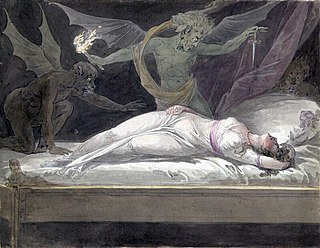
A demon is a supernatural being, typically associated with evil, prevalent historically in religion, occultism, literature, fiction, mythology, and folklore; as well as in media such as comics, video games, movies, anime, and television series.
Demonology is the study of demons or beliefs about demons, and the hierarchy of demons. They may be nonhuman, separable souls, or discarnate spirits which have never inhabited a body. A sharp distinction is often drawn between these two classes, notably by the Melanesians, several African groups, and others. The Islamic jinn, for example, are not reducible to modified human souls. At the same time these classes are frequently conceived as producing identical results, e.g. diseases.
Demonic possession involves the belief that a spirit, demon, or other entity can control a person's actions. Those who believe themselves to be possessed commonly claim that symptoms of demonic possession include missing memories, perceptual distortions, loss of a sense of control, and hyper-suggestibility. Erika Bourguignon found in a study of 488 societies worldwide that seventy-four percent believe in spirit possession, with the highest numbers of believing societies in Pacific cultures and the lowest incidence among Native Americans of both North and South America.

Aamon, in demonology, is a Grand Marquis of Hell who governs 40 infernal legions, and the 7th spirit of the Goetia.

In demonology, Beleth, also spelled Bilet, Bileth, Byleth, or Bilith, is a king of Hell who has eighty-five legions of demons under his command. He rides a pale horse, and a variety of music is heard before him, according to most authors on demonology and the most known grimoires.

In demonology, Marbas or Barbas is a demon described in the Ars Goetia. He is described as the Great President of Hell governing thirty-six legions of demons. He answers truly on hidden or secret things, causes and heals diseases, gives wisdom and knowledge in mechanical arts, and can change men into other shapes. He is depicted as a great lion that, under the conjurer's request, changes shape into a man.

In demonology, Belphegor is a demon, and one of the seven princes of Hell, who helps people make discoveries. He seduces people by suggesting to them ingenious inventions that will make them rich.
In demonology, Ziminiar or Zymymar is one of the four principal kings that have power over the seventy-two demons that are supposedly constrained by King Solomon, according to the Lesser Key of Solomon. Ziminiar is not to be conjured except on great occasions. The other three demon-kings are Amaymon, Corson, and Gaap.
Christian demonology is the study of demons from a Christian point of view. It is primarily based on the Bible, the exegesis of these scriptures, the scriptures of early Christian philosophers, hermits and the associated traditions and legends incorporated from other beliefs.

There have been various attempts throughout history by theologian scholars in the classification of Christian demons for the purpose of understanding the biblical and mythological context of adversarial spirits. Theologians have written dissertations in Christian demonology, classical occultism, classical mythology and Renaissance magic to clarify the connections between these spirits and their influence in various demons. The study of demonology was historically used to understand morality, behavioral tendencies, and has even been used as symbolism to relay anecdotal tales in with which they lure people into temptation and may also include the angels or saints that were believed to have been their adversaries; an idea which derived from the Biblical battle between the Archangel Michael and the Antichrist in The Book of Revelation (12:7-9) describing a war in heaven which resulted in Satan and his angels being expelled from Heaven. The classifications of these fallen angels are based on many other characteristics as well, such as behaviors that caused their fall from heaven, physical appearances or the methods that were used to torment people, cause maladies, or elicit dreams, emotions, etc. Most authors who wrote theological dissertations on the subject either truly believed in the existence of infernal spirits, or wrote as a philosophical guide to understanding an ancient perspective of behavior and morality in folklore and religious themes..

An incubus is a demon in male form who, according to mythological and legendary traditions, lies upon sleeping women in order to engage in sexual activity with them. Its female counterpart is a succubus. Salacious tales of incubi and succubi have been told for many centuries in traditional societies. Some traditions hold that repeated sexual activity with an incubus or succubus may result in the deterioration of health, an impaired mental state, or even death.

Demonology 101 is a webcomic written and drawn by Faith Erin Hicks from August 1999 to June 2004. It tells the story of Raven, a 16-year-old demon being raised by a human in ordinary human society. Hicks' first public work gained attention as an early story-focused webcomic, and ran for 700 pages before being concluded.
Lucifuge Rofocale, according to the Grand Grimoire, is the demon in charge of Hell's government and treasury by order of Lucifer.
Baal is a Semitic term for "Lord" or "owner".
Amy is a feminine given name.
Bifrons is Latin for "two-faced" and may refer to:
Se’īrīm are a kind of demon. Sa’ir was the ordinary Hebrew word for "he-goat", and it is not always clear what the word's original meaning might have been. But in early Jewish thought, represented by targumim and possibly 3 Baruch, along with translations of the Hebrew Bible such as the Peshitta and Vulgate, the se’īrīm were understood as demons. Se'īrīm are frequently compared with the shedim of Hebrew tradition, along with satyrs of Greek mythology and jinn of Arab culture.
Kuttichathan is a demon in Malabar demonology.







